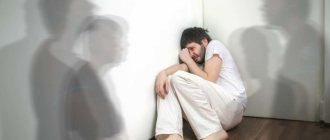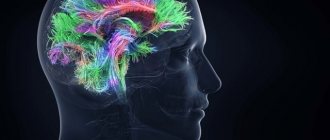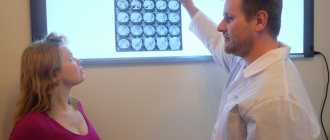History
| « | Having the misfortune of suffering from hallucinatory insanity for two years and retaining after recovery the ability to cause a certain kind of hallucination at will, I was naturally able to notice in myself some of the conditions for the origin of sensory delirium. | » |
| - psychiatrist Kandinsky. | ||
The syndrome is named after Viktor Kandinsky, the second cousin of the artist Wassily Kandinsky. In 1876-1877 Victor served in the navy as a ship’s doctor, participated in the Russian-Turkish War and suddenly felt that he had been “subjected” to the mental attack of the Tsarist secret police. But he seized control in time and went to psychiatry himself, where he was able to describe his experiences in the critical-clinical study “On Pseudohallucinations,” which was highly praised in his works by the luminary of psychiatry, Jaspers. In addition, he is considered the father of Russian forensic psychiatry.
To stop external “influence” on his brain, he committed suicide in the name of conspiracy at the peak of one of the attacks in 1889. through overload with substances.
There is not much interesting about the second half of the syndrome, about Clerambault: he was a similar schizophrenic psychiatrist-schizophrenic from France, “controlled” by Surte (this is a French FSO) and, independently of Kandinsky, described his symptoms of mental automatism.
He also came up with erotic delusions (Clerambault syndrome), the law of his name, and then fell into depression with delusions of guilt and shot himself.
What is this
It consists of the three most important things that do not occur to the average person and are a set of productive symptoms:
- Pseudo-hallucinations are hallucinations within one’s subjective world, i.e. “music playing behind the wall” is a true hallucination, and “music playing in the head” or perceived by the “spiritual/internal” sense is a pseudo-hallucination. The voices in my head are here too.
- Ideas of influence (mental and physical) - a feeling of the influence of force from the outside: as if they are “putting” thoughts into your head, “speaking” with your mouth and “walking” with your feet. Someone's invisible influence and the action of the cosmos, extraneous forces, persecution are also here.
- The very phenomena of mental automatism: the feeling of one’s thoughts/movements/actions/feelings as if made, unnatural, alienated. This can also be called forced thinking, as if someone is forcing
you to think.
That is, the patient feels the influence of his sick consciousness and hears his thoughts, as if it were a separate part of him - this is not a split personality, this is precisely a “ split of the mind”
" - what is included in the very name of the disease
schizophrenia
.
Pathological automatisms are the most characteristic feature of those patients with schizophrenia who are under the influence of an otherworldly extraneous force, which is most clearly manifested by impulsive actions against the patient’s wishes. This behavior can be dangerous.
Characteristic pathologies
The syndrome of mental automatism is most characteristic of schizophrenia, especially its paranoid form, and has an unfavorable prognosis. Cases of the occurrence of individual automatisms in somatogenic diseases and intoxications have been described; thus, this syndrome is not pathognomonic for schizophrenia.
In most cases, the appearance of this syndrome is associated precisely with schizophrenia, which is especially characterized by ideational automatisms, which in ICD-10 are considered as one of the most important signs of this disease.
Options
All types have one thing in common: the connection of sensations with external influences. Often complemented by delusional symptoms, the result is delusional ideas of influence and persecution.
Ideatorial (associative)
Here, first of all, is the very investment of other people’s thoughts and the feeling of openness of one’s thoughts, which “may” be known to others. The sound of your thoughts appears (normally the act of thinking is inseparable
and
continuous
, it is impossible to look at it “from the outside”) and the alienation of one’s emotions: “they laugh at me,” “they sadden at me,” that is, as if this is not an independent, but a forced act, under
the influence
of something extraneous.
Senestopathic
This includes the entire “space” and devices with rays that cause pseudohallucinations, senestopathies and visceral hallucinations in the patient. That is, it not only seems to him that a surveillance device has somehow been “sewn under his skin” and he “feels” it, but this also happened thanks to unknown malicious rays from another galaxy/from neighbors/magical influences.
Motor (kinesthetic)
The patient considers all movements, including walking and turning his eyes, not his own, but under the influence of others. They “go” by controlling it. A special type of motor automatism is speech motor pseudohallucinations, as if all speech, pronunciation of words and movements of the tongue also occur from external influences, and not of one’s own free will.
More
- What's next
| [ + ] Kandinsky-Clerambault syndrome? Welcome. | |
| Diseases | Schizophrenia • Drug addiction (Alcoholism) • Depression • Anxiety • Panic disorder • Bipolar disorder |
| States | Deja vu • Kandinsky-Clerambault syndrome • Down syndrome • Magifrenia • Fanaticism • Suicide • Anosognosia • Hysterical coma • Dementia (Oligophrenia • Dementia • Idiot) • ADHD |
| Phobias | Dysmorphophobia • Trypophobia |
Mental automatism
The syndrome of mental automatism or hallucinatory-paranoid syndrome (Kandinsky-Clerambault syndrome) is quite distinct and, apparently, is one of the few syndromes quite specific for schizophrenia.
This syndrome was first described by the Russian psychiatrist V.Kh. Kandinsky in 1888
In the literature on psychiatry, there is also a description of the so-called Kandinsky symptom, expressed in paroxysmal headaches with a feeling of a change in the “soil under one’s feet,” a change in position in space, and a feeling of weightlessness. Kandinsky's symptom can be detected at the initial stage of development of schizophrenia, especially during the first episode of psychosis, where it is often combined with the phenomenon of “thought cessation”. In the occurrence of Kandinsky's symptom, disorders of the autonomic nervous system and vestibular disorders apparently play a significant role (Stoimenov Y.A. et al., 2003).
In sufficient detail almost forty years after V.Kh. Kandinsky's “syndrome S” was studied by G. Clerambo (1927), based on his own observations and descriptions of other psychiatrists, including V.Kh. Kandinsky.
G. Clerambo (1942) believed that the syndrome of mental automatism is characteristic of schizophrenia.
Some psychiatrists today are confident that mental automatism is even more typical of this disease than the primary or negative symptoms. This is reflected in the diagnostic criteria of the International Classification of Diseases (ICD-10); others believe that it can occur in some organic and intoxication psychoses. The last assumption, in our opinion, is due to the vagueness of the boundaries of schizophrenia, the blurring of its nosological outlines, and possibly the fragmentation and nonspecificity of the pathological process denoted by the term “schizophrenia.”
| | If mental automatism manifests itself, you should consult a psychiatrist |
In the initial period of formation of the syndrome, the patient’s personality is subordinated to experiences that have an amorphous structure. However, in this structure one can discern certain psychopathological symptoms that form the syndrome of mental automatism.
According to the majority of French psychiatrists, the syndrome of mental automatism includes sensory or sensitive symptoms (hallucinations or “commenting voices”, “voices in the form of dialogue”), motor changes (motor, ideomotor automatisms), volitional, affective and higher (violations of the “I” ) automatisms.
Currently, the syndrome of mental automatism is characterized by three components: ideational (“suggestion of thoughts”, “extraction of thoughts”, “openness of thoughts”, etc.), which includes both pseudohallucinations and psychopathological phenomena close to them (Baillarger hallucinations); sensory or sensual, manifested by the violent experience of emotions alien to the personality or more coarse sensory experiences in the form of senestopathies and somatic hallucinations; motor or motor variant with violent, often obsessive actions.
In the reference book of the practical doctor A.G. Goffman and P.A. Ponizovsky (2006), as well as most domestic psychiatrists, include mental automatisms, pseudohallucinations, delusions of persecution and influence in the hallucinatory-paranoid syndrome.
Ideatorial (associative) automatisms usually concern changes in the processes of thinking and memory, accompanied by a feeling of alienation and violence. Patients often characterize these experiences as “influxes (mentisms), stops (sperrungs), inserting and reading thoughts,” “unwinding of memories” (the patient is forcibly forced to remember various events from the past), “filling with images.” “The echo of one’s own thoughts,” their withdrawal, prediction, investment - and all these are manifestations of the syndrome of mental automatism. A “wonderful change” seems to occur to the patient, which he often accepts with admiration and surprise, or anxiety and fear, a feeling of confusion and bewilderment.
Some psychiatrists also classify “made feelings” as ideational automatisms.
It is important to emphasize that the symptoms of ideational automatism are clothed in the core feeling that they are “done.” The patient experiences the alienness of his own thinking: “thoughts are open to others, known to others,” “people steal ideas,” “put in their thoughts.” This point of view is confirmed in the behavior and statements of others, in “repeating thoughts out loud”, “sounding one’s own thoughts.” In some cases, patients talk about “made dreams” to which they attach great importance.
Sensory or senestopathic automatisms are characterized by various painful bodily sensations, which patients interpret as specifically caused. Such sensations can have one or another localization, and often can be quite elaborate senestopathies (“overflow”, “delays”, “twisting”, “liquefaction”, etc.). Pain, paresthesia, and algia may also be “done.” Sensory automatism can grow out of hypochondriacal delusions or, on the contrary, be formed on the basis of delusional beliefs. For women with schizophrenia, sensory automatisms localized in the genital area are quite typical.
Kinesthetic or motor automatism is manifested by patients’ confidence that their movements, including complex motor acts, are imposed from the outside, alienated.
“Speech motor automatisms” include phenomena of forced speech (“speech motor hallucinations”) (Seglas J., 1888), writing, kinesthetic, verbal and graphic hallucinations.
In the dynamics of the development of the syndrome, ideational automatisms are followed by senestopathic and kinesthetic automatisms (Goffman A.G., Ponizovsky P.A., 2006).
Mental automatism syndrome, according to A.M. Khaletsky (1962) is characterized by a special loss of initiative, while the patient’s “I” is, as it were, “inscribed in a small circle in the large circle of a new parasitic personality,” in a situation of universal symbolic significance.
A detailed study of the syndrome of mental automatism showed that it is accompanied by a special experience of openness, a feeling of internal change, renewal, enrichment, new knowledge and even purpose, the phenomena of appropriation and alienation.
Mental automatism syndrome is characterized by a feeling of “passivity,” when patients feel that their thoughts, emotions, and actions are not caused by themselves, but are imposed from the outside. The patient is sure that he is being influenced in various ways. Here we can talk about a violation of the ability to identify one’s own actions.
The syndrome of mental automatism can remain peripheral in relation to the “I”, to the feeling of one’s own activity, and can be total, when the patient considers all his feelings, thoughts, movements to belong to another being.
In schizophrenia, signs of mental automatism can be found in many psychopathological formations (delusions, obsessive states, pseudohallucinations, etc.).
Some domestic psychiatrists identify separate variants of the syndrome: a delusional version of the hallucinatory-paranoid syndrome with a predominance of delusions of influence in the clinical picture, a hallucinatory version - the predominance of pseudohallucinations, an inverted version, characterized by the patients’ confidence in their ability to read the thoughts of others, instill in them their thoughts, change their behavior, influence influence on various events and objects.
Hallucinatory-paranoid syndrome can be in the structure of an acute episode of schizophrenia, in this case characterized by sensory delusions of persecution, affects of fear and confusion, often including pseudohallucinations and rudimentary symptoms of catatonia. Chronic hallucinatory-paranoid syndrome carries a tendency to systematize delusions, while vivid affective experiences fade and may be absent. As schizophrenia progresses, it is possible to transfer the patients’ own experiences to others and invert delusions: the patient himself influences those around him, “puts thoughts into them.”
Return to Contents









